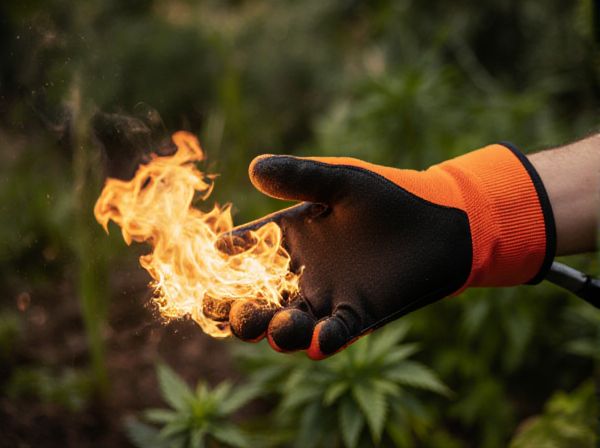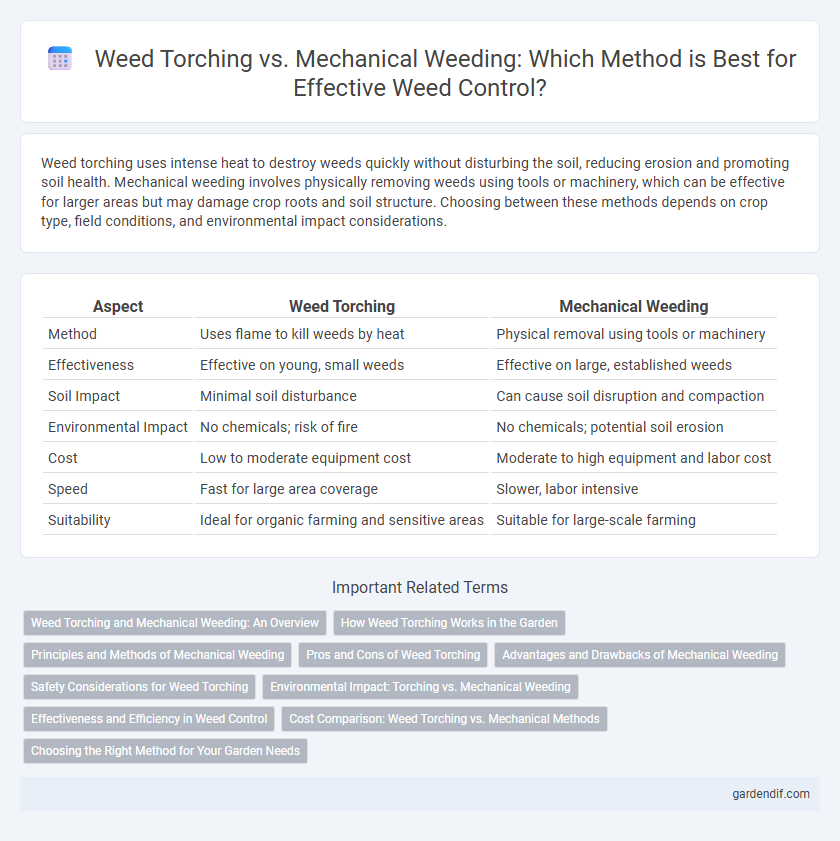
Weed torching vs mechanical weeding Illustration
Weed torching uses intense heat to destroy weeds quickly without disturbing the soil, reducing erosion and promoting soil health. Mechanical weeding involves physically removing weeds using tools or machinery, which can be effective for larger areas but may damage crop roots and soil structure. Choosing between these methods depends on crop type, field conditions, and environmental impact considerations.
Table of Comparison
| Aspect | Weed Torching | Mechanical Weeding |
|---|---|---|
| Method | Uses flame to kill weeds by heat | Physical removal using tools or machinery |
| Effectiveness | Effective on young, small weeds | Effective on large, established weeds |
| Soil Impact | Minimal soil disturbance | Can cause soil disruption and compaction |
| Environmental Impact | No chemicals; risk of fire | No chemicals; potential soil erosion |
| Cost | Low to moderate equipment cost | Moderate to high equipment and labor cost |
| Speed | Fast for large area coverage | Slower, labor intensive |
| Suitability | Ideal for organic farming and sensitive areas | Suitable for large-scale farming |
Weed Torching and Mechanical Weeding: An Overview
Weed torching effectively eliminates weeds by applying intense heat, causing cell rupture and plant death without chemical use, making it ideal for organic farming and sensitive environments. Mechanical weeding involves physically removing weeds through tools like hoes or cultivators, which disrupt soil but can be labor-intensive and less precise for certain weed species. Both methods reduce weed competition, yet weed torching offers quicker results and lower soil disturbance compared to the more traditional mechanical approach.
How Weed Torching Works in the Garden
Weed torching works by applying intense heat directly to unwanted plants, causing cell walls to rupture and leading to plant death without disturbing the soil structure. This method targets weeds at the seedling stage for optimum effectiveness, minimizing regrowth by destroying root systems near the surface. Mechanical weeding, in contrast, physically removes weeds but can cause soil displacement and increase erosion risk.
Principles and Methods of Mechanical Weeding
Mechanical weeding relies on principles of soil disturbance and plant uprooting using tools such as hoes, cultivators, and rotary tillers to disrupt weed growth without chemicals. Methods include shallow cultivation to sever weed roots and prevent photosynthesis, as well as inter-row cultivation that targets weeds between crop rows while preserving crop roots. This approach reduces weed competition by physically removing or damaging weed seedlings, promoting crop health through improved aeration and soil structure.
Pros and Cons of Weed Torching
Weed torching offers an eco-friendly alternative to chemical herbicides by using intense heat to destroy weed cellular structure without soil disruption, making it ideal for organic gardening and minimal soil erosion. However, it requires careful application to avoid fire hazards and may not effectively control deep-rooted or large weeds, potentially necessitating repeated treatments. Compared to mechanical weeding, weed torching is less labor-intensive but less precise, posing a risk of damaging nearby desirable plants if not properly managed.
Advantages and Drawbacks of Mechanical Weeding
Mechanical weeding offers advantages such as reduced chemical use, lower environmental impact, and improved soil aeration, promoting sustainable agricultural practices. However, it can be labor-intensive, less effective on deeply rooted or perennial weeds, and may cause soil disturbance leading to erosion or moisture loss. Balancing mechanical weeding with other methods is essential to optimize weed control and maintain soil health.
Safety Considerations for Weed Torching
Weed torching involves the use of open flames to eliminate unwanted plants, requiring strict adherence to safety protocols to prevent fire hazards and burns. Operators must wear protective gear, maintain a safe distance from flammable materials, and ensure compliance with local fire regulations to mitigate risks. Unlike mechanical weeding, which poses more physical injury risks, torching hazards primarily stem from heat exposure and potential wildfire ignition.
Environmental Impact: Torching vs. Mechanical Weeding
Weed torching reduces chemical use, lowering soil and water contamination risks compared to chemical herbicides often associated with mechanical weeding processes. Mechanical weeding disturbs soil structure and microbial habitats, increasing erosion potential and carbon release, whereas torching minimally disrupts soil integrity. Energy consumption varies; torching involves propane or gas combustion emissions, while mechanical weeding depends on fuel-powered equipment contributing to greenhouse gas emissions.
Effectiveness and Efficiency in Weed Control
Weed torching effectively eliminates weeds by applying direct heat to plant tissues, causing rapid desiccation and preventing regrowth without soil disturbance. Mechanical weeding, involving tools like hoes or cultivators, physically removes weeds but can be labor-intensive and may disrupt soil structure, potentially promoting new weed growth. Combining torching with mechanical methods optimizes weed control by maximizing efficiency and reducing reliance on herbicides.
Cost Comparison: Weed Torching vs. Mechanical Methods
Weed torching typically incurs lower upfront equipment costs compared to mechanical weeding machines, making it more accessible for small-scale operations. However, mechanical weeding involves higher initial investment but offers increased efficiency and reduced labor expenses over time. Evaluating long-term operational and maintenance costs is crucial for determining overall cost-effectiveness between weed torching and mechanical weeding methods.
Choosing the Right Method for Your Garden Needs
Choosing between weed torching and mechanical weeding depends on your garden's size, plant type, and weed severity. Weed torching offers a chemical-free, efficient solution for small to medium gardens by applying heat to eradicate weeds without disturbing the soil. Mechanical weeding suits larger areas or gardens with delicate plants, providing precise control and preventing damage to root systems while physically removing weeds.
Weed torching vs mechanical weeding Infographic

 gardendif.com
gardendif.com